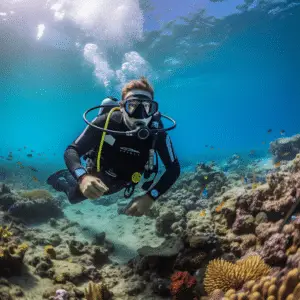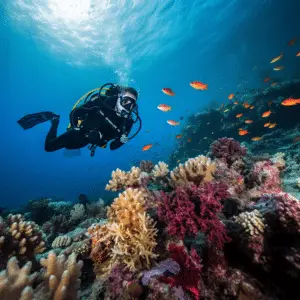Scuba diving, For someone new to the world of aquatic sports, you may look at both scuba diving and snorkeling and find yourself confused. The two share so many similarities and so it’s hard to differentiate the two and understand why they have different names.
While it’s true that the two are very similar, after all both consist of delving into the unknown and exploring the beauty that sea life has to offer. Some distinct differences between the two makes them two very different sports. There has always been an air of mystery for novice aquatic sportsmen as to what those distinct differences really are. It falls under the list of very common questions that people hold about aquatic sports, but never really ask. To clear some of these up quickly; No the plot of 47 meters down isn’t realistic and no sand is not fish poop. Now that we have that cleared up, let’s look into snorkeling and scuba diving features that make the two so different.
The purpose of the two

Though it would be easy to say that both activities are used for recreational purposes at first glance, it can be said that scuba diving has a far bigger range of uses. It isn’t really used more than to observe wildlife or have fun for snorkeling, which makes it much lower level than scuba diving. Again, scuba diving does in fact have its recreational uses. In fact, it could be argued that scuba diving’s main user base scuba dive only for fun. However beyond that there are plenty more uses for the activity.
You may not know this, but there are actually many teams in the engineering sector specially trained in scuba diving. This is because, in many offshore engineering facilities, a lot of the work they do is actually done underwater. This works in instances such as oil rigs or any other offshore facility. Thus, a lot of engineers who work in that sector are required to work underwater to complete repairs or even put things together.
People trained in snorkeling would never really be able to do this, as it requires far more qualifications than what you would receive from your standard snorkeling training.
Scuba diving also has a lot of use in terms of helping people at sea. There have been plenty of cases where someone’s boat has capsized or a swimmer has found themselves pulled along with the current. There is a sector of rescue divers who have received all of the necessary training to help people who have found themselves in a difficult situation at sea. Once again, someone who does snorkeling would not have this know-how and would not be able to offer the same service as someone with a lot of training in scuba diving.
Equipment
One of the main areas where you will distinguish between the two activities is through the equipment that they both use. Though they share some similarities, there are many things that scuba diving requires in comparison to the requirements that snorkeling has. For example, when it comes to snorkeling, you will never go too deep into the water so you won’t need to learn how to use a dive compass. There are also many other bits of equipment that one sport uses and the other doesn’t, as well as equipment that they both share.
Snorkel
Obviously, if you go snorkeling you are going to use a snorkel. This is the main bit of kit that you are going to find yourself using as a snorkeller. Snorkels not only allow snorkelers to breathe when underwater, but they also create limitations on how deep into the water they can travel. A snorkel has limitations on the length that it can be to ensure that the user can breathe as well as possible, which means that snorkelers will never be able to go as deep as a scuba diver. Scuba divers don’t use snorkels as the main intention of diving is to reach depths for exploration, which a snorkel wouldn’t allow.
Oxygen Tank
Unless you choose to freedive, if you are scuba diving, you will be using oxygen tanks. Oxygen tanks allow the user to reach low depths in the water while also being able to breathe simultaneously. The oxygen tank is arguably one of the most valuable bits of equipment that a scuba diver will use, as they essentially keep them alive when they are under the water’s surface. Snorkelers do not require an oxygen tank aid as they use snorkels to source air from above the surface, which is a very distinguishable difference between the two.
Full face mask
In the world of scuba diving, you will likely encounter a full-face scuba mask. These are extremely useful and help combat some ailments that scuba divers need to overcome while exploring the ocean’s depths. Full face masks allow the oxygen from their tanks to feed straight into their masks, making breathing underwater much easier. This bit of equipment is not used during snorkeling, as snorkelers use a mouth tube and snorkel instead and a full face mask would only get in the way.
Buoyancy control device
Though there is a long list of more technical equipment that scuba divers need to use in order to ensure that they are safe while under the water, one of the most frequently used pieces of equipment is a buoyancy control device. This is usually in the form of a jacket and helps the scuba diver keep a neutral buoyancy when underwater. It is also utilized a lot when the diver is trying to ascend back to the surface as it makes the process much faster. Aside from the average life vest, scuba divers really don’t need to use a buoyancy control device as they won’t be traveling too deep into the water.
Training
As well as using other equipment, there is also a vast difference in the training that is required in order to scuba dive as opposed to snorkeling.
Snorkeling requires little to no training at all. This is because of just how straightforward the activity is. In fact, that is one of the main reasons that snorkeling is such a popular activity that people do when they are on holiday, as it requires very little know-how. Before you snorkel, the instructor will likely just give you a quick rundown on how to use the snorkel and how to breathe properly while underwater. This would take less than ten minutes and after this, you would be free to take to the water.
Scuba diving takes a lot of training and you would not be allowed to even get in the water to do it without the appropriate certifications. This is the case because there is a lot that you need to know before you attempt scuba diving and it is much more complicated than snorkeling. Even entering the water requires a lot more thought and technique and so it would be irresponsible to let just anyone do it whenever they want.
The risks
Though both activities come with their own risks, it is hard to deny that there are considerably more risks in the world of scuba than there is for snorkelers.
This is for several reasons, such as the difference in depths that you will explore depending on which sport you decide to do.
Predators

When you are snorkeling, it is much more likely that you will be doing it in shallow bodies of water. This is because there are limitations to how far down you can go and if you want to get a good view of what the ocean has to offer, you aren’t going to get it by exploring the top section of deep water. Because of this, people will often snorkel in isolated areas or even closer to the shore. Due to where snorkelers choose to snorkel, they are less likely to fall victim to predators.
Though coming in contact with predators is unlikely, it is still possible when you are out at sea. This is why scuba divers take so many precautions to ensure that they don’t bring any unnecessary attention to themselves, such as making sure that they don’t wear bright clothing or items that could be reflective.
Snorkelers don’t need to take all of these precautions and they don’t even need to wear a wetsuit if they don’t want to, as calling attention to a shark is an unlikely event to occur. However, snorkelers still need to be worried about potentially hurting themselves when they are doing the activity, as they will still be exposed to coral and sea life.
